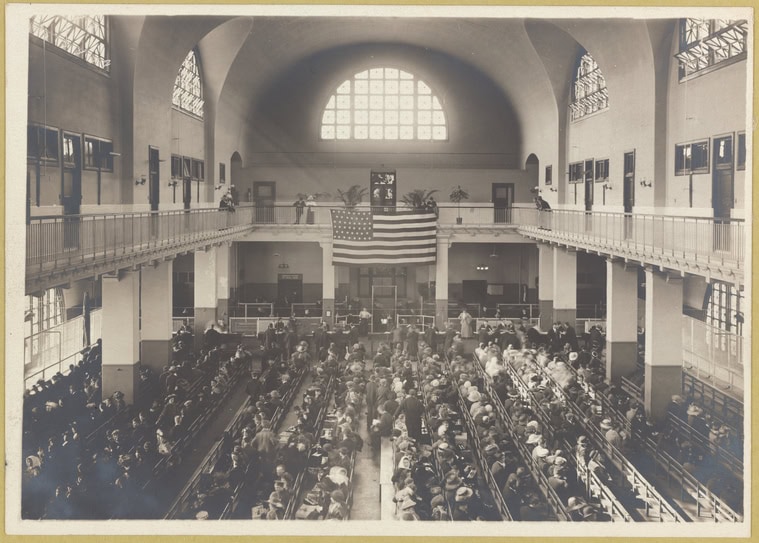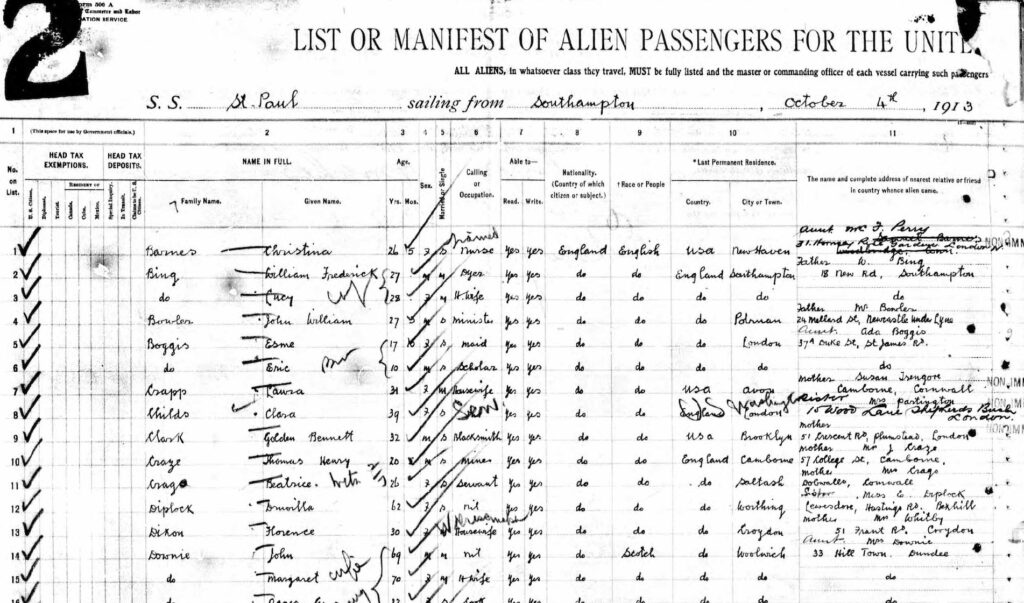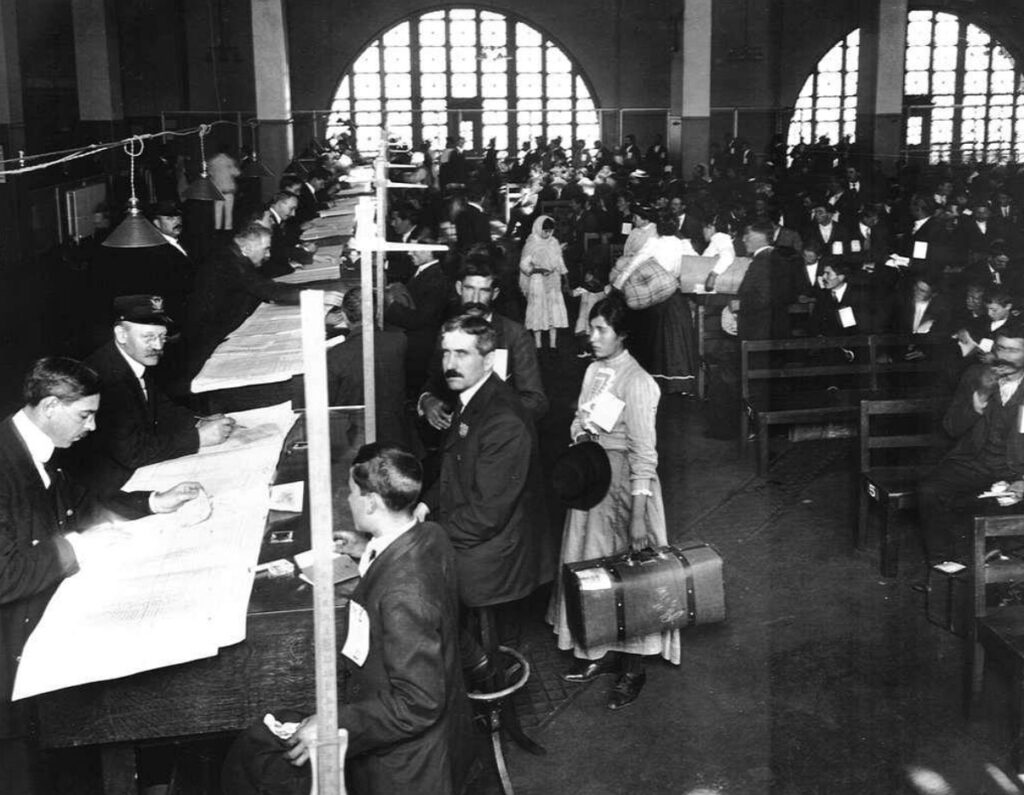Grandpa swore his original last name was 9 syllables and 17 letters long until that harried Ellis Island clerk scribbled ‘Smith’ on his papers.
Family legend or historical fiction? Get ready for the surprising truth…
We’ve all heard some version of this story—Ukrainian ancestors becoming “Johnson” because no one could pronounce “Yevheniuk,” or Great-Grandma Rosalina becoming simply “Rose” the moment she stepped onto American soil.
These Ellis Island name-change tales have become deeply embedded in our national consciousness—repeated at family gatherings, immortalized in films, and passed down through generations as undisputed fact.
But what really happened at America’s most famous immigration station is even more fascinating than the myth.
The truth about how immigrant names changed reveals a story not of bureaucratic blunders, but of remarkable human adaptation and agency in the face of a new world.
Find Your Ancestors' Immigration Story
Ellis Island was a gateway for millions—was your family among them?
Find your family's past with just a name search.
Hollywood vs. Reality: How Ellis Island Actually Processed Immigrants
Remember that iconic scene in The Godfather Part II where young Vito Andolini becomes Vito Corleone after an Ellis Island official misreads his hometown as his surname?
It’s dramatic, emotional, and one of my favorite scenes to watch as a genealogist.
But it’s completely inaccurate.
Sorry, Francis Ford Coppola got it wrong.
Ellis Island officials actually had no authority to change immigrants’ names.
None. Zero. Zilch.
The reality was less cinematic but no less chaotic. Imagine entering the cavernous Great Hall, your ears ringing with a symphony of languages as thousands of exhausted travelers shuffled through inspection lines.

The echoing space filled with crying babies, shuffling feet, and nervous whispers. But amid this chaos was surprising order—a process designed to verify, not rewrite, your identity.
Turns out those overwhelmed clerks had less power than your average Starbucks barista misspelling names on coffee cups.
Their job was to check your identity against existing ship manifests that had already been filled out in your home country—not rename you on a whim.
The Paper Trail That Debunks the Myth
If officials changed names at Ellis Island, where’s all the paperwork? Where are the records of these millions of name-changing transactions?
They don’t exist—because it didn’t happen that way.
The truth lies in the ship manifests—documents created before immigrants ever set foot on American soil.
Here’s an example of a ship manifest for my great-grandfather from 1913:

These passenger lists were created at the port of departure in Europe, not upon arrival in America. Ellis Island inspectors worked with documents already in existence, checking names off against these pre-written lists.
True or False: Ellis Island officials were required to Americanize names.
Answer: False! They were required to verify the names matched existing documentation.
Here’s the kicker: steamship companies faced hefty fines if their manifests contained inaccurate information. They had serious financial incentive to get those names right.
Speaking of paperwork, here’s a historical nugget most people miss: the Steerage Act of 1819 kicked off the whole manifest system in the first place.
This law required ship captains to hand over detailed passenger lists to U.S. officials—creating America’s first standardized immigration records.
What started as basic lists evolved into the multi-page, multi-column documents used during the Ellis Island years.
By the 1890s, these records were meticulously maintained, with shipping companies hiring dedicated clerks just to get the details right.
So not only did officials lack the authority to change names—they were working within a documentation system specifically designed to maintain accuracy across international borders.
The Real MVPs: Ship Manifest Clerks Abroad
The unsung heroes of immigration documentation were actually the clerks in European ports. These were the people who first recorded immigrant names—often in cramped ticket offices in Hamburg, Naples, Rotterdam, or Liverpool.
Picture this: A nervous family from rural Slovakia standing in a crowded Hamburg office, clutching their life savings and trying to communicate with a German clerk who speaks neither Slovak nor English.
That interaction—not anything that happened at Ellis Island—was the most likely source of any name confusion.
Ellis Island: America’s Most Multilingual Workplace of Its Time
Imagine a workplace where nearly 1 in 3 employees spoke multiple languages. That was Ellis Island—America’s original diversity powerhouse.
At its peak, Ellis Island employed interpreters who collectively spoke more than 30 languages and dialects, from Yiddish to Ruthenian to Lithuanian.

These weren’t just casual speakers—they were professional interpreters hired specifically to ensure accurate communication.
By 1907, Ellis Island had created a sophisticated system where “difficult cases” were referred to dedicated language specialists.
One legendary interpreter, Fiorello La Guardia (yes, the future mayor of New York City), spoke Italian, Yiddish, Croatian, German, and Hungarian. He once reportedly switched between five languages in a single inspection line.
More languages were spoken daily at Ellis Island than at the United Nations today. So why would officials randomly change names they had the linguistic capability to understand?
The Name-Change Timeline: When Immigrants Actually Became “American”
The real story of immigrant name changes looks more like this:
1890s: Giuseppe arrives at Ellis Island, correctly documented as “Giuseppe Rossi” on all paperwork.
1900: Giuseppe, tired of being called “Gee-seppe” by his foreman at the textile mills, introduces himself as “Joe” at his new factory job.
1905: His mail comes addressed to “Joe Rossi.”
1910: His American-born children never use “Giuseppe,” only knowing their father as “Dad” or “Joe.”
1920s: Joe officially signs documents as “Joe Rossi,” completing the transition without any legal paperwork.
The name change wasn’t just about sounding American—it was often about survival. As one Italian immigrant wrote in his memoir:
“I didn’t change my name because I was ashamed. I changed it because I couldn’t feed my family when no one would hire Vincenzo. But Vincent could get work.”
Consider the case of the Kozioziemski’s from Poland. When Stanisław Kozioziemski arrived in 1910, his name was correctly recorded on all documents.
But within his first year in Chicago, he noticed something: mail would frequently get lost, job applications went unanswered, and foremen struggled to call him for shifts.
By 1912, he began introducing himself as “Stan Kims” at the steel mill.
His paychecks came in that name, he signed his apartment lease that way, and his American friends never attempted his full surname.
DIY Name Changes: No Court Required
Turns out, your great-grandparents could wake up one day and decide “I’m Bob now” with zero paperwork. Before the 1930s, legal name changes through court orders were rare and unnecessary.
You could adopt any name you wanted as long as you weren’t trying to defraud anyone. Your “legal name” was simply whatever name you commonly used—a flexibility almost unimaginable in our ID-obsessed era.
The name on your Social Security card became the de facto “official” name for many Americans, creating standardization that hadn’t existed before the 1930s.
Why We Love the Ellis Island Myth (Even Though It’s Wrong)
Why do we cling to these Ellis Island name-change stories despite overwhelming evidence to the contrary?
The myth portrays our ancestors as helpless victims of bureaucracy rather than active agents in their own Americanization.
There’s something almost comforting about blaming an anonymous government official rather than acknowledging that our great-grandparents strategically shed ethnic identifiers to blend in.
The truth—that many immigrants deliberately changed their own names to avoid discrimination or simply to assimilate—forces us to confront America’s complicated history of both welcoming immigrants and pressuring them to conform.
What’s often missing from this conversation is the intense pressure immigrants faced in early 20th-century America.
Many encountered “No Italians Need Apply” signs, housing discrimination against those with Jewish surnames, or workplace harassment over “unpronounceable” Slavic names.
Changing one’s name wasn’t just about fitting in—it was sometimes necessary for economic survival in a society that hadn’t yet embraced multiculturalism.
Understanding these pressures adds crucial context to our ancestors’ choices, revealing their name changes as strategic responses to a complex and often hostile environment rather than casual assimilation.
Uncovering Your Family’s True Name Story
The Ellis Island myth may be comforting in its simplicity, but your family’s actual name-change story is likely more nuanced and empowering.
Rather than accepting family lore at face value, you can uncover the authentic narrative with some strategic research.
Start by examining these key historical documents:
- Ship manifests on Ancestry.com, FamilySearch.org, or EllisIsland.org to see the original recorded name
- Naturalization papers, which often document both original and Americanized versions of names
- Census records from 1900-1940 to track the gradual evolution of family names
- Early Social Security applications that sometimes reveal name discrepancies
- Military registration cards from both World Wars, which have helped countless researchers identify exactly when and how family names evolved
- Ethnic newspapers, which often printed announcements when community members formally changed names
What you’ll likely discover is a pattern of gradual change—not an abrupt renaming at Ellis Island.
You might find your ancestor using their birth name on arrival documents, then gradually adopting an Americanized version in workplace records, and finally embracing the new name completely on later legal documents.
These discoveries tell a more complex and meaningful story about your ancestors’ journey. Rather than having their identity stripped away by an overworked clerk, they strategically navigated a new culture, making deliberate choices about which parts of their heritage to maintain and which to adapt.
Their name changes weren’t mistakes but thoughtful responses to the challenges of building a new life.
So next time Aunt Mildred insists that great-grandpa Moishe became Morris when that stern Ellis Island inspector couldn’t pronounce his name, you can gently share what your research has revealed.
The documented reality of how immigrants typically changed their own names tells a more empowering story about their resourcefulness and agency in crafting their American identities.
From Family Legend to Family Truth
Remember that 17-letter surname Grandpa swore was shortened by a harried clerk?
The real story is likely both simpler and more profound.
That name probably changed gradually—perhaps first in the nervous scrawl of a European ship manifest clerk, or in your ancestor’s own handwriting as they signed a first lease, or when they introduced themselves to new neighbors in a strange land.
The documented reality—that immigrants typically changed their own names gradually and intentionally—tells a more empowering story about their resourcefulness and agency.
Our ancestors weren’t passive victims of bureaucratic mishaps but strategic navigators of a new culture. They made deliberate choices about which parts of their identity to preserve and which to adapt.
Far from diminishing their immigrant experience, this truth actually elevates their journey. It transforms them from confused newcomers at the mercy of government officials to active participants crafting their American identities with purpose and foresight.
And isn’t that a more inspiring family legacy? Not a story of what was taken from them, but of what they built for themselves—and ultimately, for us.
For more, read my guide to Strategies for Tracing Ancestors Through Immigration Records
Find Your Ancestors' Immigration Story
Ellis Island was a gateway for millions—was your family among them?



My great grandfather came over from Ireland in the last 1800s I seem to remember a story about “dropping” the Mc portion Cafferty in the ocean on the trip over.
Why are you writing “Guiseppe” instead of “Giuseppe”? If it were “Guiseppe”, it would be pronounced with a hard “g” as in “got”.
Apparently because I can’t type 🙂